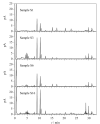[Determination of gypenoside XLVI and LVI in Gynostemma pentaphyllum from Fujian by ultra-high performance liquid chromatography-charged aerosol detector]
- PMID: 36156630
- PMCID: PMC9520372
- DOI: 10.3724/SP.J.1123.2022.01024
[Determination of gypenoside XLVI and LVI in Gynostemma pentaphyllum from Fujian by ultra-high performance liquid chromatography-charged aerosol detector]
Abstract
Gynostemma pentaphyllum (Thunb.) Makino contains dammarane-type triterpenoid saponins, similar to ginseng, with a host of pharmacological activities. However, its planting resources and chemical composition are quite complex. The chemical constituents of Gynostemma pentaphyllum vary drastically among different origins and varieties. Thus, the corresponding quality control methods also need to be different. Currently, limited information is available about the quality control of Gynostemma pentaphyllum from Fujian. A new method based on ultra-high performance liquid chromatography-charged aerosol detection (UHPLC-CAD) was established for the determination of gypenoside XLVI and LVI in Gynostemma pentaphyllum. The major components of Gynostemma pentaphyllum were characterized using UHPLC-quadrupole time-of-flight-mass spectrometry (UHPLC-Q-TOF/MS) combined with UHPLC-CAD. The results revealed gypenoside XLVI, LVI, and their corresponding malonyl-containing acidic saponins as the main components. However, malonylgypenoside XLVI and LVI can easily remove their malonyl group and convert to gypenoside XLVI and LVI during the application of Gynostemma pentaphyllum. In this study, the samples were pretreated using alkali hydrolysis to transform the acid saponins completely, and the final contents of gypenoside XLVI and LVI were determined via UHPLC-CAD. The optimal alkaline hydrolysis, extraction, and liquid chromatography conditions were established. First, the alkaline hydrolysis conditions were optimized. The effects of the volume of ammonia and reaction time on the contents of gypenoside XLVI, LVI, malonylgypenoside XLVI, and LVI were examined. Malonylgypenoside XLVI and LVI could be transformed completely to gypenoside XLVI and LVI by standing for 24 h in an ethanol-water-ammonia (50∶46∶4, v/v/v) mixture. Furthermore, the extraction conditions were optimized. Next, effects of the different solvents, extraction time, and solid-liquid ratio on the extraction rates of gypenoside XLVI and LVI were investigated. The extraction method for Gynostemma pentaphyllum powder using the ethanol-water-ammonia (50∶46∶4, v/v/v) and a solid-liquid ratio of 1∶150 (g∶mL) for 30 min was established. Finally, a prepared test solution was separated on a Waters ACQUITY UPLC BEH C18 chromatographic column (100 mm×2.1 mm, 1.7 μm). Acetonitrile and 0.1% (v/v) formic acid aqueous solution were used as the mobile phases for gradient elution. The flow rate was set to 0.5 mL/min and column temperature was maintained at 40 ℃. The separation was detected using a charged aerosol detector. Results indicated that the logarithm of the mass concentrations of gypenoside XLVI and LVI had a linear relationship with the logarithm of the peak area in the range of 9.94-318.00 μg/mL and 12.78-409.00 μg/mL, respectively. The correlation coefficients (r) were 0.9993 and 0.9995, respectively. The limit of detection (LOD) and the limit of quantification (LOQ) of gypenoside XLVI were 1.58 μg/mL and 6.36 μg/mL, respectively. The LOD and LOQ of gypenoside LVI were 2.05 μg/mL and 8.18 μg/mL, respectively. The relative standard deviations (RSDs) of precision, repeatability, and 24 h stability were less than 2.0% (n=6). The spiked recoveries of gypenoside XLVI were 100.2%-107.2% and the RSD value was 2.4%. The spiked recoveries of gypenoside LVI were 97.9%-104.2% and the RSD value was 2.6%. The results of 16 batches of Gynostemma pentaphyllum samples indicated that the gypenoside XLVI content was 0.57%-2.57%, and gypenoside LVI content was 0.66%-2.99%. Hence, this method has high sensitivity and good reproducibility. Therefore, it can be used for quality research and quality control of Gynostemma pentaphyllum from Fujian.
该研究利用超高效液相色谱-电雾式检测器(UHPLC-CAD)建立了福建产绞股蓝中绞股蓝皂苷XLVI和LVI含量的测定方法。首先利用超高效液相色谱-四极杆-飞行时间质谱(UHPLC-Q-TOF/MS)结合UHPLC-CAD鉴定了福建产绞股蓝的主要成分,其中绞股蓝皂苷XLVI、LVI以及二者相应的含丙二酰基酸性皂苷为其主成分,因此在含量测定时先进行碱水解预处理将酸性皂苷转化为对应的去丙二酰基中性皂苷,再利用UHPLC-CAD测定碱水解后绞股蓝皂苷XLVI和LVI的含量。将绞股蓝样品粉末在乙醇-水-氨水(50∶46∶4, v/v/v)和料液比1∶150(g∶mL)条件下超声提取30 min,静置24 h后,在Waters ACQUITY UPLC BEH C18色谱柱(100 mm×2.1 mm, 1.7 μm)上分离,采用0.1%(v/v)甲酸水溶液和乙腈作为流动相进行梯度洗脱,流速0.5 mL/min,柱温40 ℃,电雾式检测器检测。结果表明,绞股蓝皂苷XLVI和LVI分别在9.94~318.00 μg/mL和12.78~409.00 μg/mL范围内具有良好的线性关系,相关系数(r)分别为0.9993和0.9995。方法精密度、重复性和24 h稳定性试验的相对标准偏差(RSD)均小于2.0%(n=6),绞股蓝皂苷XLVI与LVI的加标回收率分别在100.2%~107.2%与97.9%~104.2%范围内,RSD值分别为2.4%与2.6%。16批绞股蓝样品含量测定结果显示:绞股蓝皂苷XLVI含量占0.57%~2.57%,绞股蓝皂苷LVI含量占0.66%~2.99%。该方法灵敏度高,重复性好,可用于福建产绞股蓝的质量研究和质量控制。
Keywords:
Figures
Similar articles
-
[Simultaneous quantitative analysis of nine saponins in Gynostemma pentaphyllum before and after heat processing based on UPLC-Q-Trap-MS].Zhongguo Zhong Yao Za Zhi. 2021 Oct;46(20):5314-5319. doi: 10.19540/j.cnki.cjcmm.20210702.201. Zhongguo Zhong Yao Za Zhi. 2021. PMID: 34738435 Chinese.
-
Simultaneous determination of gypenoside LVI, gypenoside XLVI, 2α-OH-protopanaxadiol and their two metabolites in rat plasma by LC-MS/MS and its application to pharmacokinetic studies.J Chromatogr B Analyt Technol Biomed Life Sci. 2015 Nov 15;1005:9-16. doi: 10.1016/j.jchromb.2015.09.028. Epub 2015 Sep 25. J Chromatogr B Analyt Technol Biomed Life Sci. 2015. PMID: 26454343
-
Determination by UPLC-MS of four dammarane-type saponins from heat-processed Gynostemma pentaphyllum.Biosci Biotechnol Biochem. 2014;78(2):311-6. doi: 10.1080/09168451.2014.882751. Epub 2014 Apr 14. Biosci Biotechnol Biochem. 2014. PMID: 25036687
-
Antidiabetic potentials of gypenosides: A review on the preclinical effects in glucose and insulin modulation as well as diabetes-related complications.Naunyn Schmiedebergs Arch Pharmacol. 2025 May 24. doi: 10.1007/s00210-025-04265-x. Online ahead of print. Naunyn Schmiedebergs Arch Pharmacol. 2025. PMID: 40411617 Review.
-
Advances in ultra-high-pressure and multi-dimensional liquid chromatography instrumentation and workflows.Anal Sci Adv. 2021 Mar 16;2(3-4):171-192. doi: 10.1002/ansa.202100007. eCollection 2021 Apr. Anal Sci Adv. 2021. PMID: 38716447 Free PMC article. Review.
Cited by
-
[Fingerprint of sophorolipids based on ultra-high performance liquid chromatography-charged aerosol detection].Se Pu. 2023 Aug;41(8):722-729. doi: 10.3724/SP.J.1123.2022.12025. Se Pu. 2023. PMID: 37534560 Free PMC article. Chinese.
References
-
- Chen S S. Journal of Systematics and Evolution, 1995(4): 403
- 陈书坤. 植物分类学报, 1995(4): 403
-
- Pham H T T, Ha T K Q, Cho H M, et al.. J Nat Prod, 2018, 81(11): 2470 - PubMed
-
- Kim Y H, Kim S M, Lee J K, et al.. Rec Nat Prod, 2019, 14(2): 116
-
- Wang J, Zhao M, Cheng X, et al.. J Agric Food Chem, 2020, 68(1): 193 - PubMed
MeSH terms
Substances
LinkOut - more resources
Full Text Sources
Miscellaneous






